Thierry Mugler’s Art of Fashion: Avant-Garde and Iconic
Thierry Mugler’s art redefined the boundaries of fashion, blending creativity, drama, and innovation. His bold silhouettes and futuristic...
Errika Gerakiti 30 December 2024
23 September 2024 min Read
The Victoria and Albert Museum in London is one of the leading museums focusing on art and design. It’s special to me due to the vast range of its collection, excluding no material or technique. V&A collects everything from ancient Chinese ceramics through Japanese kimonos to Alexander McQueen haute couture dresses. Moreover, the vast portion of the collection that is not on display is made available for browsing online.
Whenever online shopping becomes dangerous for my wallet or may result in slow starvation until the next payday, I go for the safer option. No less fun, though. Pick a word, color, thing, or technique and explore V&A’s collection. I usually start with the featured ones and then dig deeper into the complete catalog. I get to see beautiful things—in a way not much different from online shopping—but I cannot buy them, which is probably for the best. And on top of that, I usually learn something new. Today, we’ll look at the beautiful kimonos from the V&A collection.
(Fun fact: the plural of kimono in the Japanese language is also kimono, as Japanese does not distinguish plural nouns.)
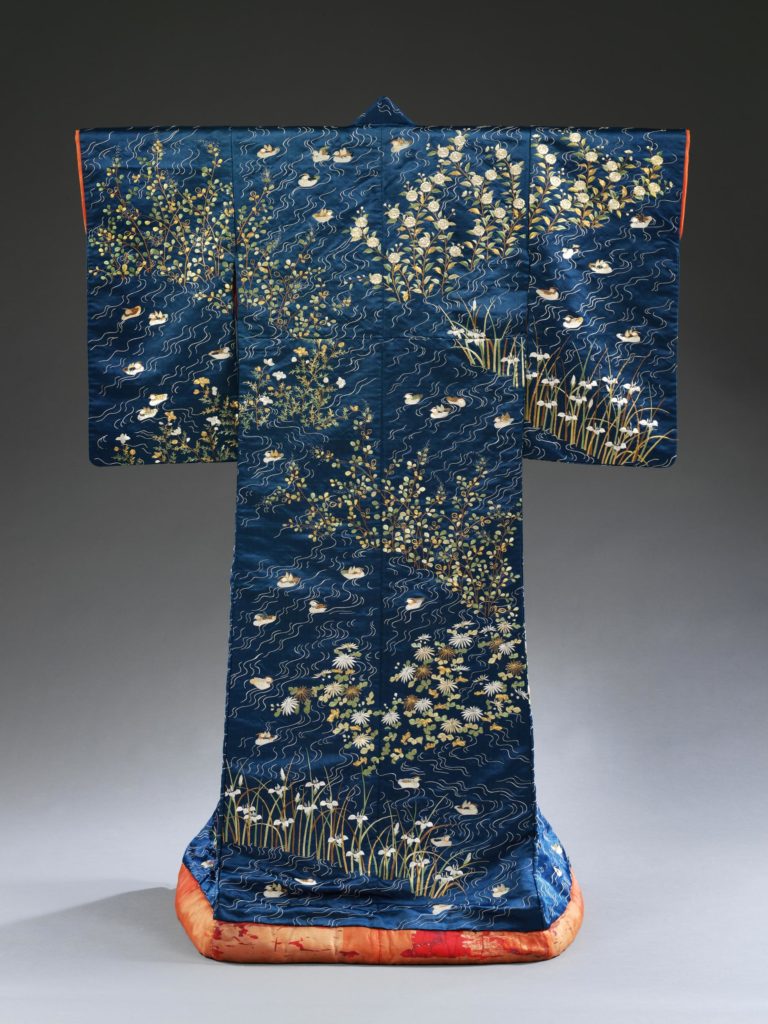
The combination of delicate embroidery and dark blue satin fabric gives this kimono a striking, lustrous appearance. It has a design of ducks on rippling water among flowers. Paired ducks are a symbol of marital harmony, so this kimono may have been part of a wedding trousseau (the clothes, linen, and other belongings collected by a bride for her marriage).
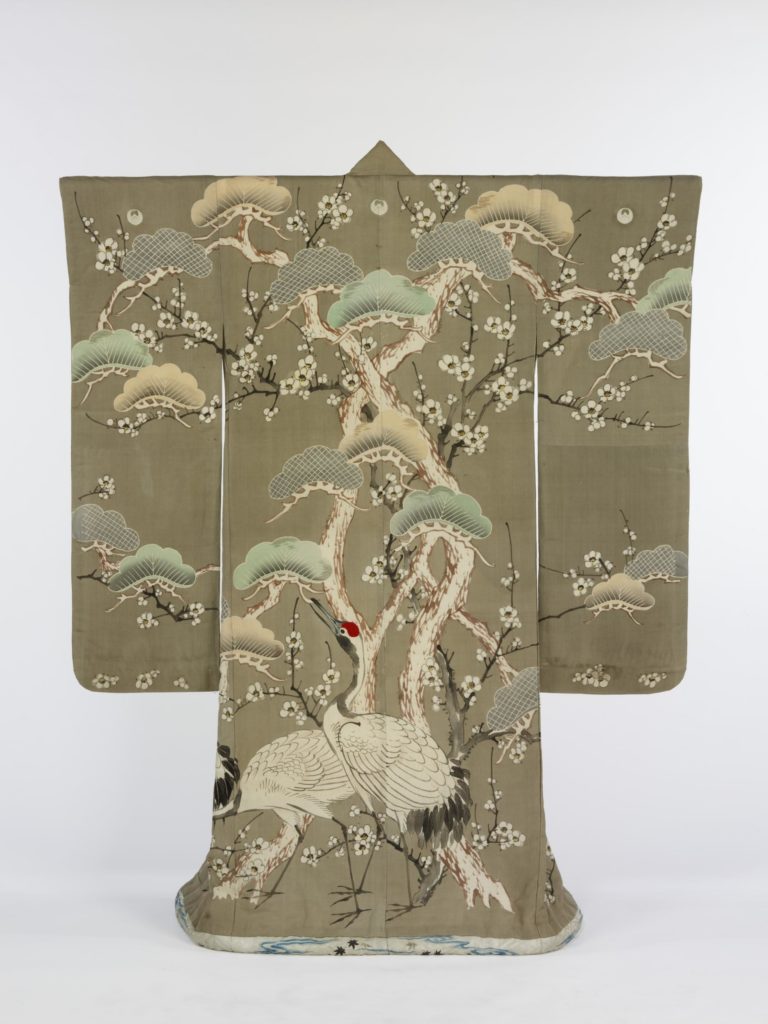
The design of this kimono illustrates the close connection between painting and textile arts in Japan. The surface of the garment has acted as a kind of hanging scroll for the creation of a hand-painted and dyed image of cranes among pines and plum blossoms. Touches of embroidery highlight the birds’ crests and parts of the pine boughs.
The red-crowned crane, also called the Manchurian or Japanese crane, is a large East Asian crane among the rarest cranes in the world. In some parts of its range, it symbolizes luck, longevity, and fidelity.
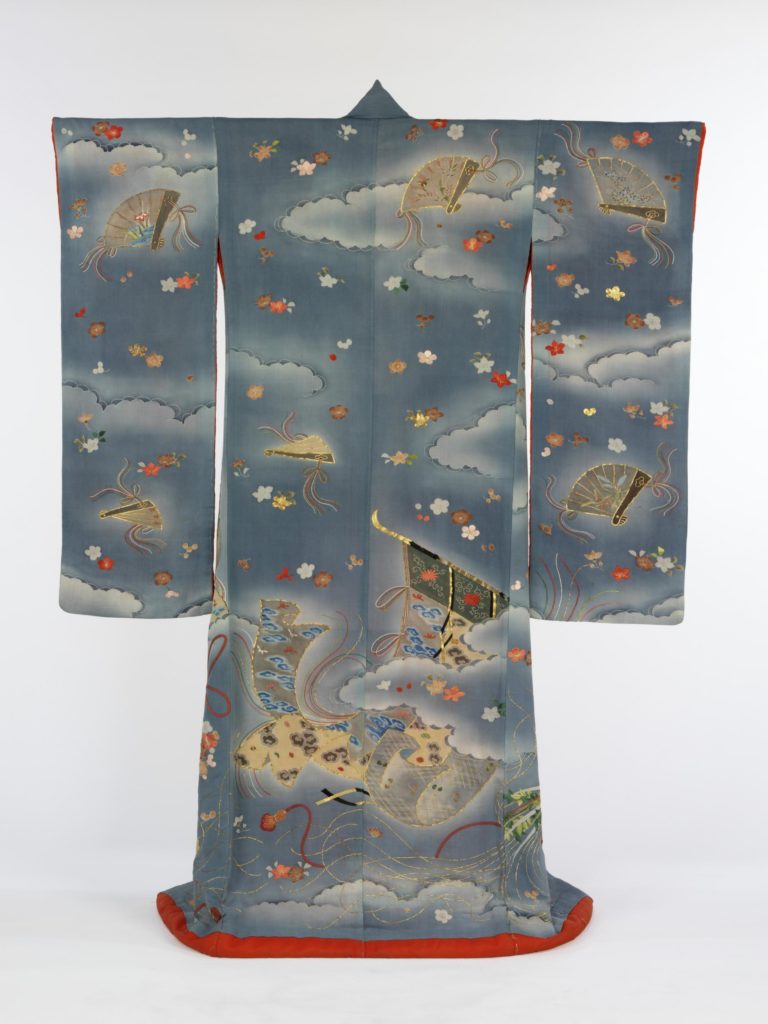
This elegantly patterned kimono celebrates the beauty of textiles through its decoration—which depicts lengths of fabric hung on an elaborate stand and gently fluttering in the breeze surrounded by clouds, fans, and falling cherry blossoms. The design was created using a technique called yuzen. This involves drawing the pattern on the cloth with rice paste extruded through the metal tip of a cloth bag. The paste forms a protective coat that prevents the color from penetrating when the dyes are applied.
Here, the skills of the dyer have been enhanced by those of the embroiderer, who has highlighted the stand and the edges of the fabrics in gold and added flowers, blossoms, and elaborate ties and tassels in pink, white, and green.
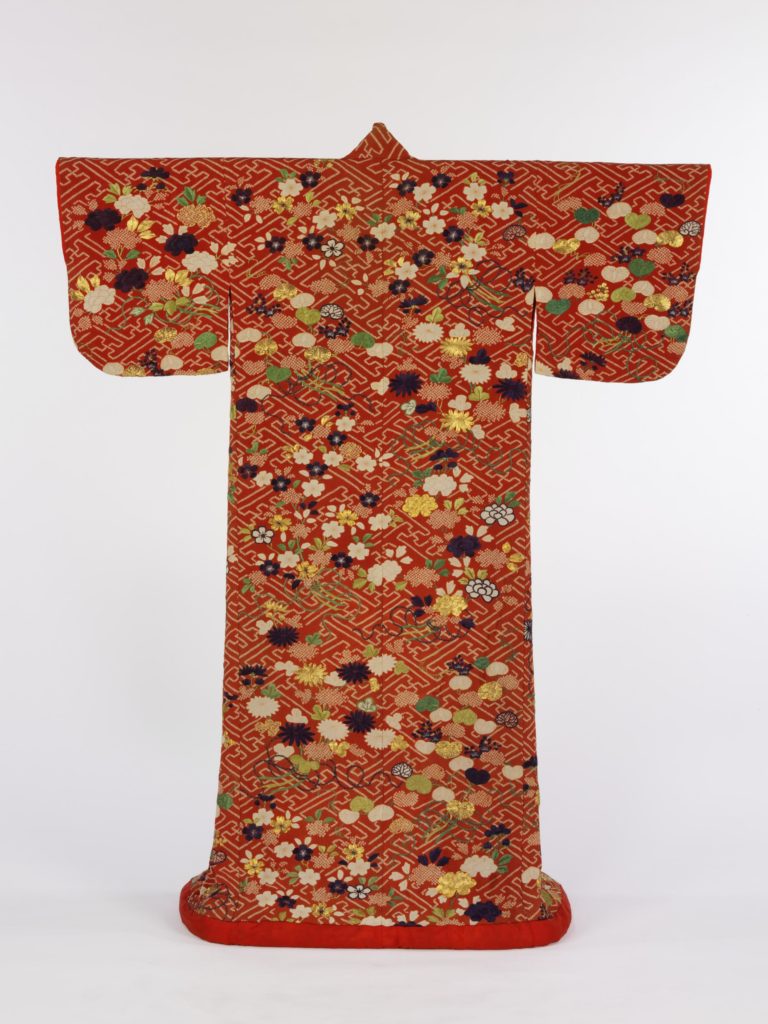
The white-spotted parts of the pattern on this striking red kimono were created using a method called shibori. In this technique, tiny sections of cloth are bound with thread before being dyed. The color does not penetrate the protected areas. After the dye is dry, the binding is carefully removed. Shibori was costly and labor-intensive and was usually combined with embroidery, as in this kimono. The dense pattern of peonies, chrysanthemums, and hollyhocks combined with a key-fret pattern is characteristic of kimonos worn by women of samurai families.
The Japanese peony considered the “King of Flowers,” has a symbolic meaning that includes wealth, good fortune, honor, daring, and masculine bravery. The peony originated in China and was introduced to Japan around the 8th century.
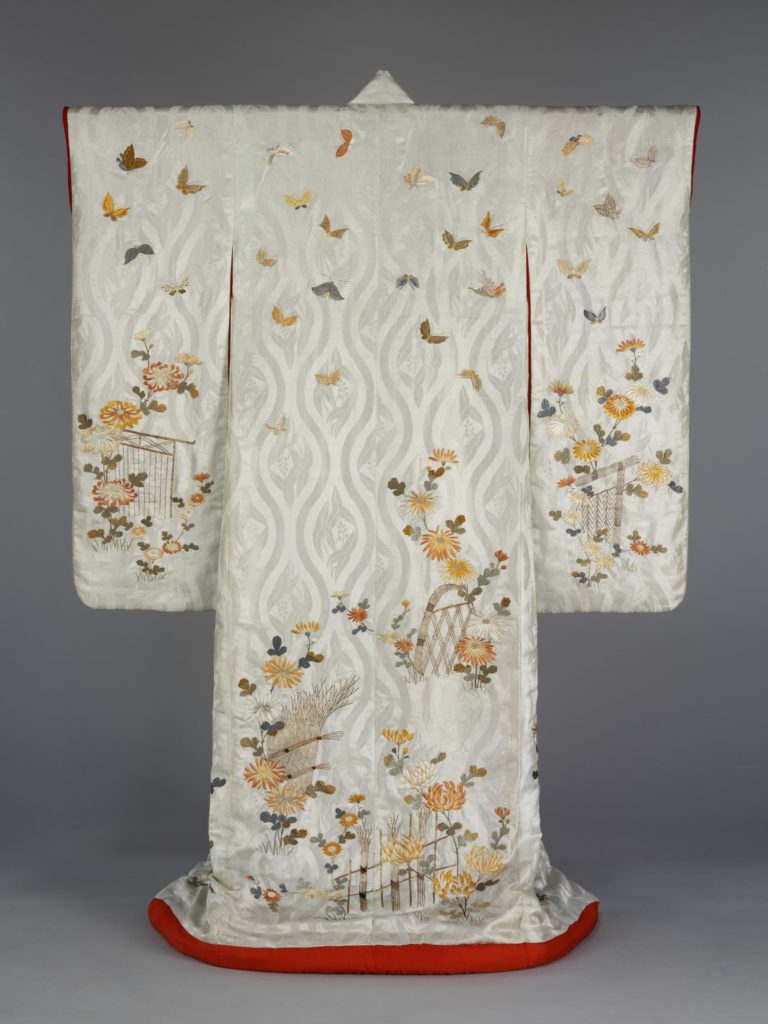
The outer kimono (uchikake) with long swinging sleeves (furisode) is embroidered with white-figured silk satin, padded, and lined with red satin. Long hanging sleeves are lined with red silk crêpe. The opulence of this kimono suggests it was probably worn by a bride. The shimmering white ground has been embroidered with chrysanthemums and other flowers and large butterflies, no two of which are the same.
The chrysanthemum, or Kiku in Japanese, symbolizes longevity and rejuvenation. When first introduced to Japan during the Nara period (710–793 CE), the Japanese Royal Family was fascinated with them. Eventually, they became the Imperial Family emblem.
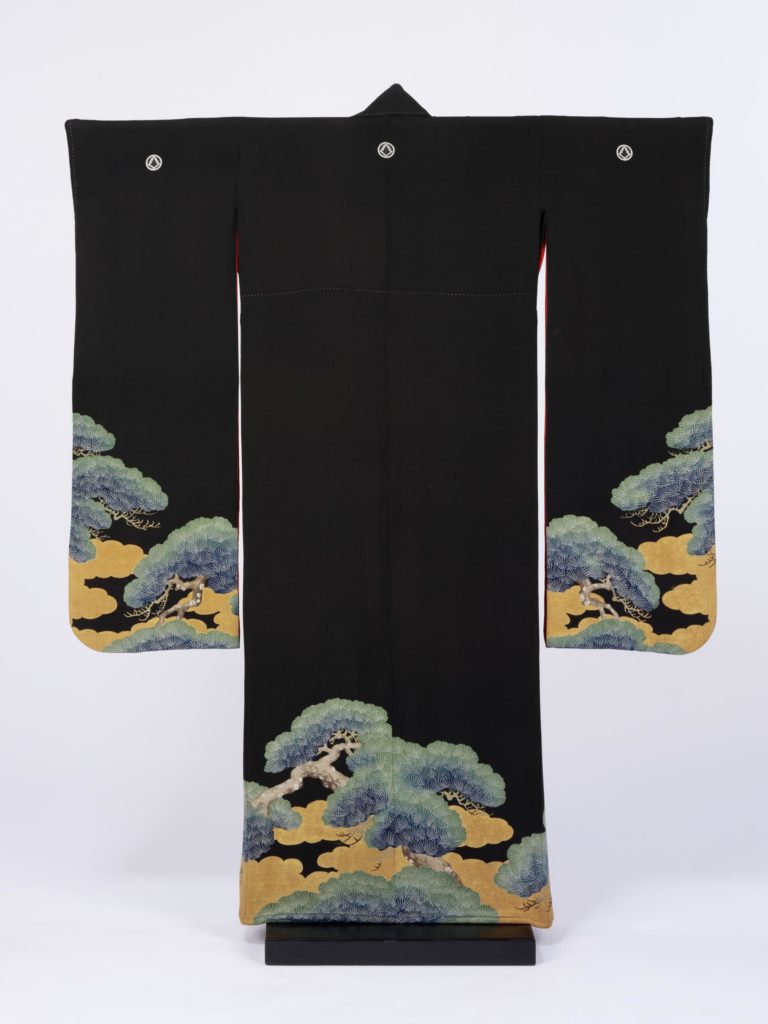
The elegant design of pine trees on this kimono was created using a technique called yuzen. This involves drawing the pattern on the cloth with rice paste extruded through the metal tip of a cloth bag. The paste forms a protective coat that prevents the dye from penetrating. The large patterned areas were then completely blocked with paste before the background color was applied. The cloudy areas were created using gold leaf, and tiny parts of the design have been highlighted with touches of embroidery.
In Japanese culture, the pine tree represents longevity, good fortune, and steadfastness. It is commonly linked with virtue and long life, even immortality. The pine tree is iconic of the Japanese New Year, symbolizing rebirth, renewal, and a bright (hopeful) future.
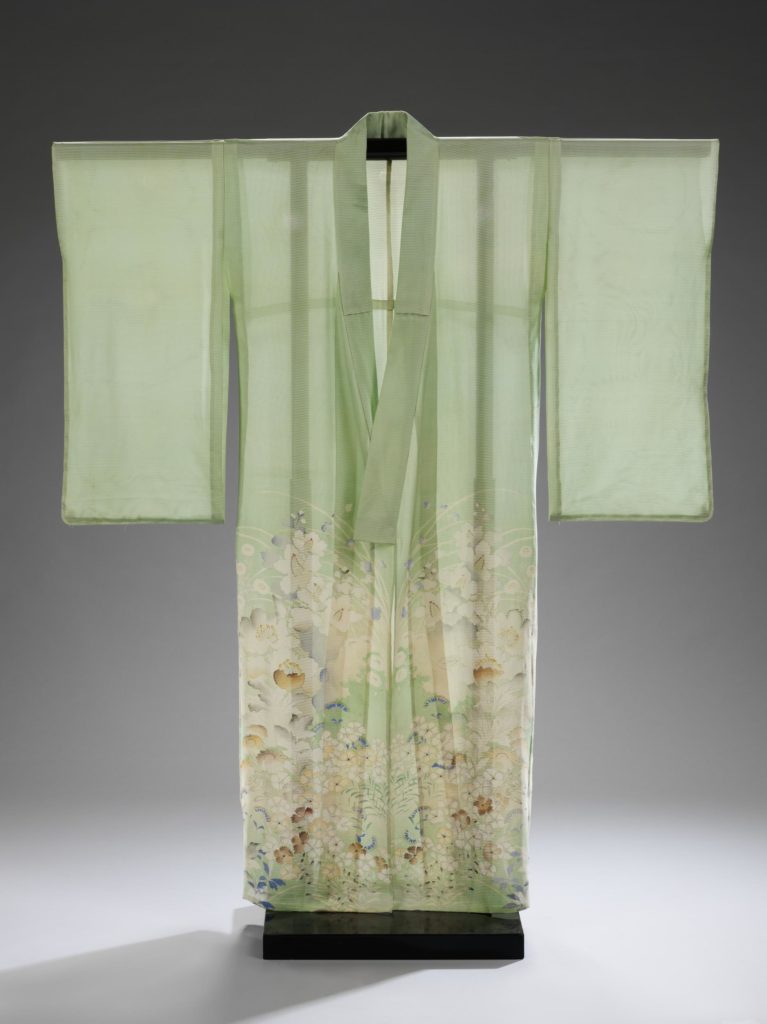
The fabric of this kimono is ro, a type of silk gauze in which rows of plain weave alternate with one where adjacent warps cross over each other, resulting in an “open” horizontal stripe. The soft, fine fabric is ideal for unlined summer kimonos. It has been dyed a delicate green color and patterned with flowers, including hibiscus (fuyō) and dianthus (nadeshiko), the latter a Japanese symbol of femininity.
Before the 20th century, the focus of the pattern was always on the back of the kimono, but this shifted, as seen here, to the lower front. The five crests indicate that the kimono was designed to be worn for formal occasions. It was part of a complete ensemble acquired by American Bernice Eileen Boo, who taught at the Narimasu High School in Grant Heights, Tokyo, Japan, from 1957–1959.
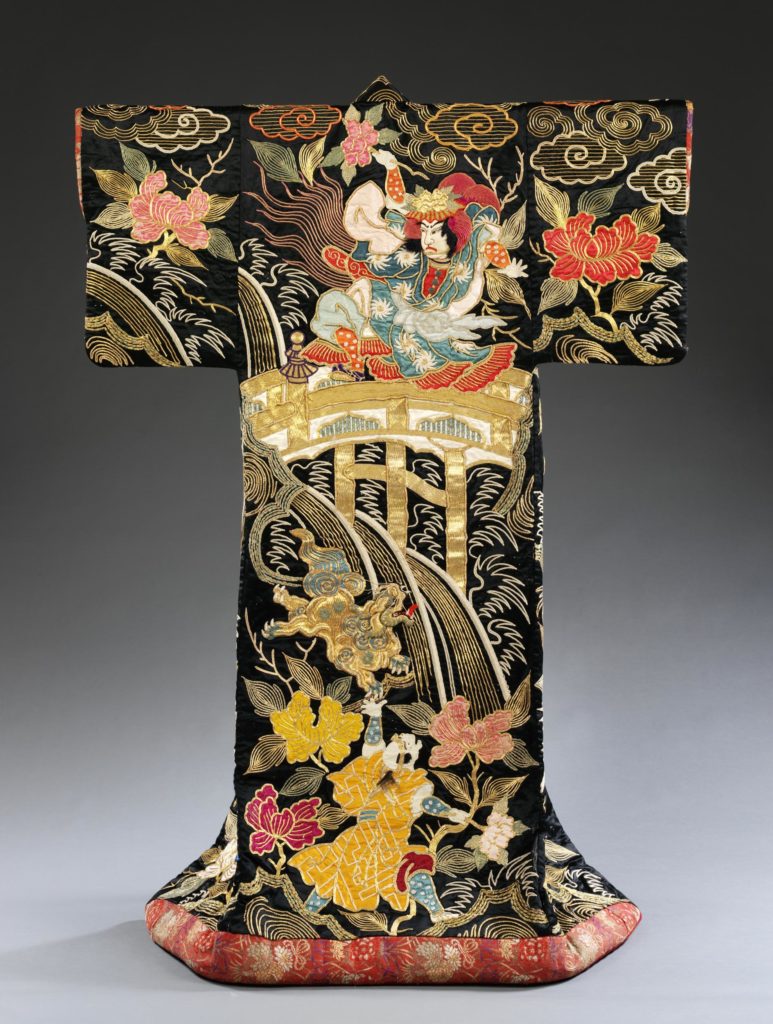
The motif on this extremely exuberant outer kimono (uchikake) is a theatrical one relating to the Chinese legend of Shakkyo (Stone Bridge). This refers to a bridge over a steep gorge near the summit of Mount Seiryo, which is reputed to lead to the Buddhist paradise and is guarded by mythical lions (shishi).
The kabuki play adapted from this story culminates in a dramatic shakkyomono or lion dance. The figure on the bridge is a kabuki actor who embodies the spirit of the shishi, while below, actual shishi are depicted with other figures surrounded by peonies. Costumes worn on stage certainly needed to be flamboyant and eye-catching, but the motifs were not usually so literal. It is more likely, therefore, that this kimono belonged instead to a high-ranking courtesan.
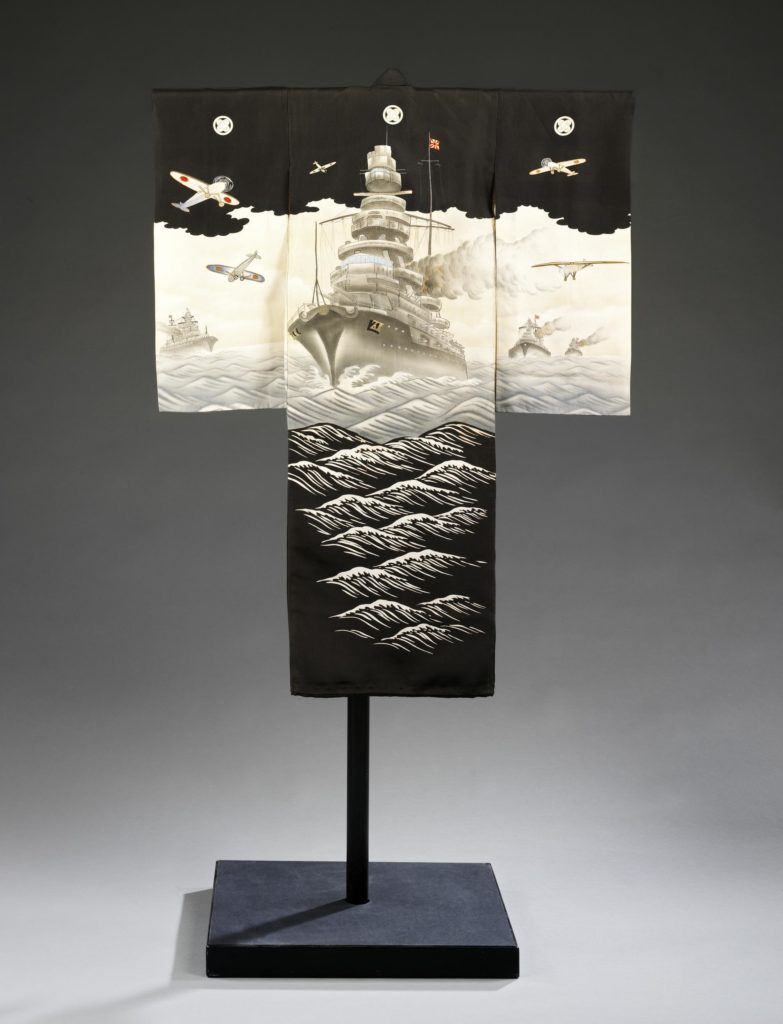
A child’s first visit to a Shinto shrine, about 30 days after birth, marked an essential rite of passage when parents would thank the gods and a priest would pray for the baby’s health and happiness. Infant boys would wear kimonos with motifs symbolic of achievement and strength. In the 1930s, sometimes, contemporary nationalistic images replaced the traditional samurai ones. This kimono features battleship designs referencing Japan’s aggressive expansion in East Asia. It would have symbolically wrapped around the young child in wishes for his and the nation’s future.
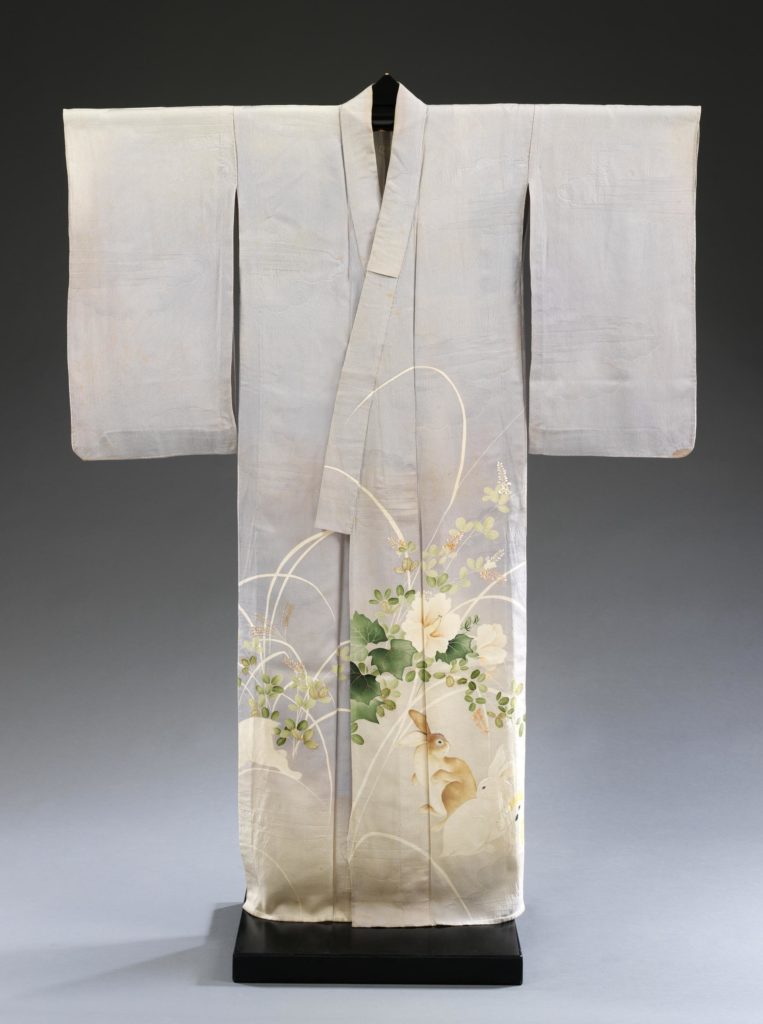
This beautiful kimono is decorated with an autumnal motif of rabbits playing among flowers and grasses by the light of a moon, which shines softly down from the shoulder of the garment. The design has been created using a free-hand resist dyeing technique with special touches, such as the faces and ears of the rabbits, in silk embroidery. The ground fabric has been woven with a cloud motif, suggesting a night sky. Geisha may have worn this kimono.
Because rabbits only move forward and don’t step back, people consider them lucky, and they are a symbol of advancement. The rabbit is also a symbol of cleverness and self-devotion in myths. In the old days, it was a symbol of spring.
DailyArt Magazine needs your support. Every contribution, however big or small, is very valuable for our future. Thanks to it, we will be able to sustain and grow the Magazine. Thank you for your help!